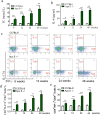Gr-1⁺CD11b⁺ immature myeloid cells (IMC) promote resistance of pro-inflammatory T cells to suppression by regulatory T cells in atherosclerotic Apo E- deficient mice
- PMID: 25269085
- PMCID: PMC4182509
- DOI: 10.1371/journal.pone.0108620
Gr-1⁺CD11b⁺ immature myeloid cells (IMC) promote resistance of pro-inflammatory T cells to suppression by regulatory T cells in atherosclerotic Apo E- deficient mice
Abstract
Accumulating evidence indicates that both defects in Treg numbers and/or function as well as resistance of effector T cells to suppression may contribute to the development of human chronic inflammatory diseases. However, which mechanism involved in the progression of atherosclerosis remains unclear. In this study, we evaluated the production and function of CD4⁺ inflammatory and regulatory T cells in atherosclerosis-prone mice. We found that the hyperactivity and unresponsiveness to Treg-mediated suppression of inflammatory CD4⁺ T cells occurred in the progression of atherosclerosis, though Treg cells were present in very large numbers and fully functional. We further found that Gr-1⁺CD11b⁺ immature myeloid cells were significantly accumulated in atherosclerotic Apo E⁻/⁻ mice, and they promoted resistance of inflammatory CD4⁺ T cells to Treg-mediated suppression in vitro and in vivo. we further confirmed that Gr-1⁺CD11b⁺ immature myeloid cells produced high level of interleukin 6 which was at least partially responsible for inducing unresponsiveness of inflammatory CD4⁺ T cells to suppression via activation of Jak/Stat signaling pathway. Taken together, these findings might provide new insights to explore potential targets for immune therapeutic intervention in atherosclerosis.
Conflict of interest statement
Figures





Similar articles
-
Defective leptin/leptin receptor signaling improves regulatory T cell immune response and protects mice from atherosclerosis.Arterioscler Thromb Vasc Biol. 2007 Dec;27(12):2691-8. doi: 10.1161/ATVBAHA.107.149567. Epub 2007 Aug 9. Arterioscler Thromb Vasc Biol. 2007. PMID: 17690315
-
Treg-mediated suppression of atherosclerosis requires MYD88 signaling in DCs.J Clin Invest. 2013 Jan;123(1):179-88. doi: 10.1172/JCI64617. Epub 2012 Dec 21. J Clin Invest. 2013. PMID: 23257360 Free PMC article.
-
CD11b+Gr-1+ myeloid-derived suppressor cells reduce atherosclerotic lesion development in LDLr deficient mice.Cardiovasc Res. 2016 Aug 1;111(3):252-61. doi: 10.1093/cvr/cvw114. Epub 2016 May 27. Cardiovasc Res. 2016. PMID: 27234908
-
Suppressors of cytokine signaling modulate JAK/STAT-mediated cell responses during atherosclerosis.Arterioscler Thromb Vasc Biol. 2009 Apr;29(4):525-31. doi: 10.1161/ATVBAHA.108.173781. Epub 2009 Jan 22. Arterioscler Thromb Vasc Biol. 2009. PMID: 19164812
-
Treg cells in atherosclerosis.Mol Biol Rep. 2021 May;48(5):4897-4910. doi: 10.1007/s11033-021-06483-x. Epub 2021 Jun 12. Mol Biol Rep. 2021. PMID: 34117978 Review.
Cited by
-
Atherosclerosis: a chronic inflammatory disease mediated by mast cells.Cent Eur J Immunol. 2015;40(3):380-6. doi: 10.5114/ceji.2015.54603. Epub 2015 Oct 15. Cent Eur J Immunol. 2015. PMID: 26648785 Free PMC article. Review.
-
Breaking Free of Control: How Conventional T Cells Overcome Regulatory T Cell Suppression.Front Immunol. 2016 May 18;7:193. doi: 10.3389/fimmu.2016.00193. eCollection 2016. Front Immunol. 2016. PMID: 27242798 Free PMC article. Review.
References
-
- Laurat E, Poirier B, Tupin E, Caligiuri G, Hansson GK, et al. (2001) In vivo downregulation of T helper cell 1 immune responses reduces atherogenesis in apolipoprotein E-knockout mice. Circulation 104: 197–202. - PubMed
-
- Gao Q, Jiang Y, Ma T, Zhu F, Gao F, et al. (2010) A critical function of Th17 proinflammatory cells in the development of atherosclerotic plaque in mice. J Immunol 185: 5820–5827. - PubMed
Publication types
MeSH terms
Substances
LinkOut - more resources
Full Text Sources
Other Literature Sources
Medical
Research Materials

